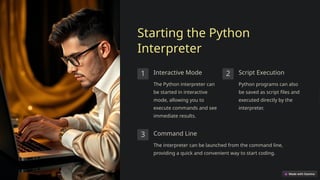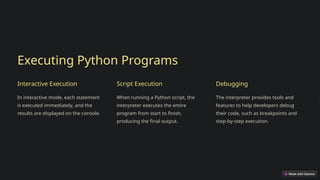Introducing-the-Python-Interpreter. What is Python Interpreter
- 1. Introducing the Python Interpreter The Python interpreter is the core component that executes Python code, whether in interactive mode or through script files. It provides a powerful and flexible platform for developers to write, test, and run their programs. SS by Shashikant Sathe
- 2. Starting the Python Interpreter 1 Interactive Mode The Python interpreter can be started in interactive mode, allowing you to execute commands and see immediate results. 2 Script Execution Python programs can also be saved as script files and executed directly by the interpreter. 3 Command Line The interpreter can be launched from the command line, providing a quick and convenient way to start coding.
- 3. Executing Python Programs Interactive Execution In interactive mode, each statement is executed immediately, and the results are displayed on the console. Script Execution When running a Python script, the interpreter executes the entire program from start to finish, producing the final output. Debugging The interpreter provides tools and features to help developers debug their code, such as breakpoints and step-by-step execution.
- 4. Interactive vs. Script Execution Interactive Mode Ideal for quick testing, experimenting, and exploring the language. Allows immediate feedback and exploration. Script Execution Better for developing and running larger, more complex programs. Scripts can be easily shared, version controlled, and executed repeatedly. Combination Developers often use a combination of interactive mode and script execution, depending on the task at hand.
- 5. The Execution Model 1 Source Code Python code is written in the .py file format, containing high-level, human-readable statements. 2 Bytecode Generation The interpreter converts the source code into a lower-level, machine-readable bytecode representation. 3 Execution The interpreter then executes the bytecode, performing the instructions and producing the final output.
- 6. The Python Interpreter Workflow Input The interpreter receives the Python code, either from an interactive session or a script file. Parsing The code is parsed and validated, ensuring it follows the Python syntax rules. Bytecode Generation The validated code is then transformed into a lower-level bytecode representation. Execution The bytecode is executed by the interpreter, which performs the necessary operations and produces the output.
- 7. Interpretation vs. Compilation Interpreted Languages Python is an interpreted language, where the interpreter executes the code line by line, without a separate compilation step. Compiled Languages Compiled languages, such as C or Java, go through a separate compilation step to generate machine-executable code. Differences Interpreted languages are generally more flexible and easier to use, while compiled languages can offer better performance.
- 8. Execution Model Variations CPython The standard Python implementation, which uses an interpreter to execute the bytecode. Jython A Python implementation that runs on the Java Virtual Machine (JVM). PyPy A Python implementation that uses just-in-time (JIT) compilation for improved performance.
- 9. Just-In-Time (JIT) Compilation 1 Source Code The Python source code is first converted to bytecode, just like in the standard interpreter. 2 JIT Compilation The JIT compiler analyzes the bytecode and generates optimized machine code on-the-fly. 3 Execution The optimized machine code is then executed, providing a significant performance boost over the standard interpreter.
- 10. Conclusion: Python's Execution Options 1 Flexibility Python offers a variety of execution models, allowing developers to choose the one that best fits their needs. 2 Performance Innovations like JIT compilation can significantly improve the performance of Python programs. 3 Ecosystem The Python community has developed a rich ecosystem of tools and implementations to enhance the language's capabilities.









